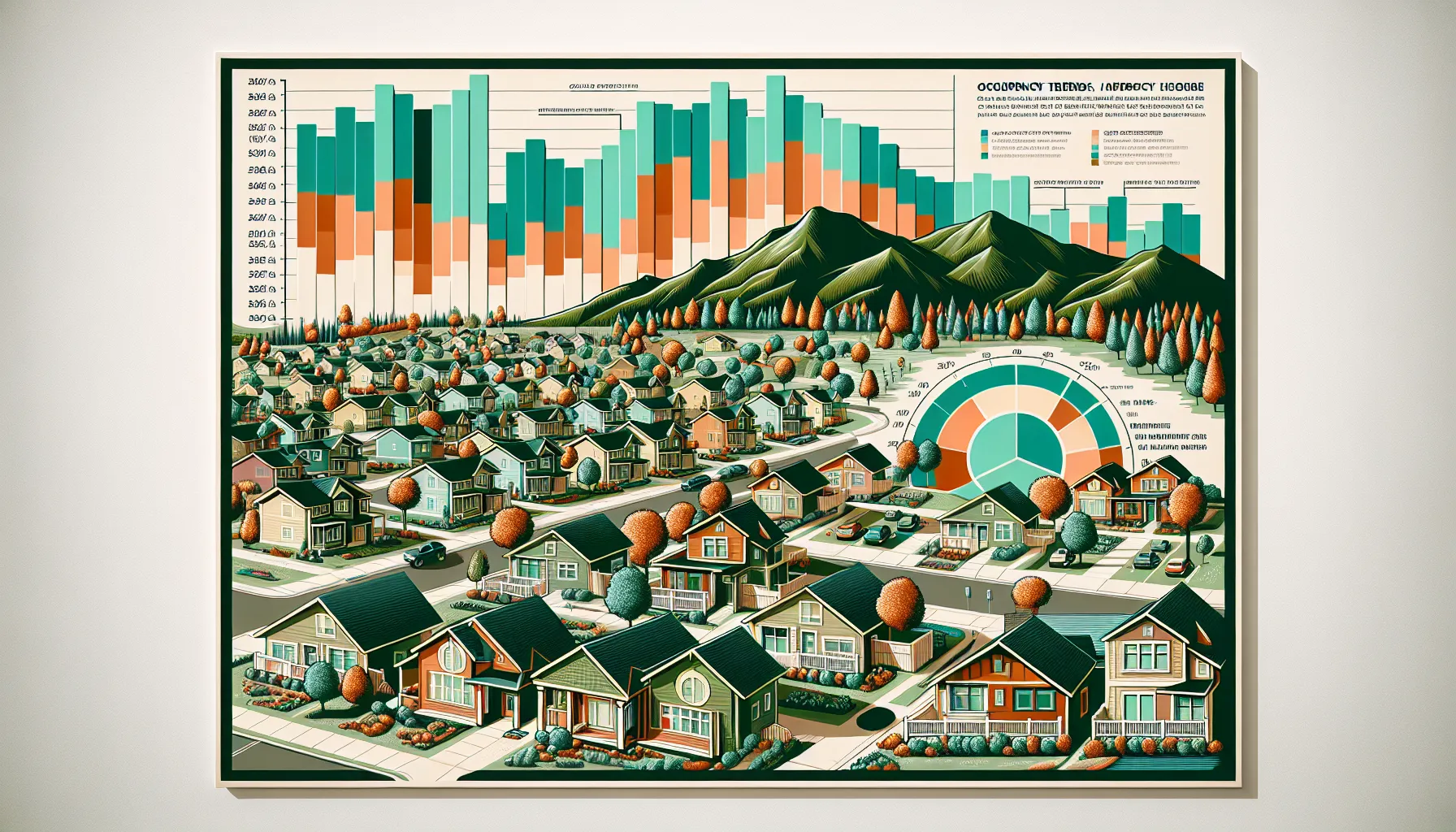Key Takeaways
- Understanding occupancy trends is vital for Elk Grove investors and property owners, as it helps maximize returns and minimize risks by aligning strategies with market demands.
- Key factors influencing occupancy include population growth, seasonal leasing trends, rental pricing, and neighborhood-specific attributes, such as proximity to schools and amenities.
- Family-friendly suburbs like Laguna Creek and Franklin consistently maintain high occupancy rates, driven by access to schools, essential services, and community-focused environments.
- Data-driven tools like analytics software and heat maps provide valuable insights, helping property owners track tenant preferences, assess market shifts, and refine rental pricing strategies.
- Challenges like data inconsistencies, geographic variability, and seasonal fluctuations can complicate trend analysis, making consistent and accurate data collection essential.
- Future trends in Elk Grove indicate sustained demand in family-oriented neighborhoods, with opportunities for growth by incorporating tenant-focused strategies, such as flexible leases and eco-friendly upgrades.
Understanding occupancy trends in Elk Grove can feel overwhelming, especially with the area’s growing popularity and diverse housing options. Whether you’re a homeowner holding onto an investment or an investor managing multiple properties, staying informed about these trends is essential for maximizing returns and minimizing risks. But where do you start?
What drives changes in occupancy rates? How do local factors like neighborhood preferences or market shifts impact rental demand? These are the questions that shape the decisions of property owners and investors alike. By analyzing these patterns, you can make smarter choices that align with your goals and the market’s needs.
In this article, I’ll break down the key factors influencing occupancy trends in Elk Grove. From understanding local dynamics to spotting opportunities, you’ll gain insights to help you stay ahead in this competitive market. Let’s explore how data can guide your next move.
Understanding Occupancy Trends In Elk Grove
Occupancy trends in Elk Grove reflect the area’s growing reputation as a desirable place to live. With its diverse neighborhoods and expanding housing market, understanding these trends requires focusing on key influencing factors. How do factors like school districts, proximity to amenities, or job opportunities affect occupancy rates? Exploring these questions can help homeowners and investors make thoughtful decisions.
Elk Grove’s population growth has contributed to increased demand for rental properties. Suburbs like Laguna Creek and Franklin showcase high appeal due to their family-friendly environments and access to essential services. This growth prompts consideration of what motivates tenants to choose specific properties or neighborhoods.
Seasonal shifts also play a pivotal role. Summer often sees a spike in leasing activity as families and individuals plan moves around school and work schedules. However, shifts in economic conditions or local policies could alter typical patterns. Staying informed helps in adapting rental strategies to maximize occupancy throughout the year.
Rental pricing is another critical factor. Competitive rates, aligned with current market conditions, attract tenants while maintaining steady income streams. Overpricing can deter potential renters, while underpricing may reduce returns. Balancing these elements is crucial for property owners aiming to achieve long-term consistency in tenancy.
Importance Of Occupancy Trend Analysis

Analyzing occupancy trends allows stakeholders in Elk Grove to make informed decisions, adapt to shifting demand, and maximize potential opportunities. By understanding patterns in tenant preferences and property performance, homeowners and investors can better align their strategies with market conditions.
Benefits For Urban Planning
Occupancy trend data directly influences urban development decisions. Planners rely on this information to gauge population density, housing needs, and infrastructure demands. How do local community initiatives or transportation improvements affect occupancy rates? By linking these patterns to future needs, planners can prioritize investments in schools, parks, and public transit, creating sustainable growth for the city.
Impact On Local Businesses
Understanding occupancy trends benefits businesses by revealing shifts in consumer demographics and spending habits. If specific neighborhoods experience occupancy surges, businesses can strategically establish themselves in these high-demand areas. Are retailers, restaurants, and service providers meeting the needs of incoming residents? Analyzing these dynamics enhances community engagement and supports economic vitality.
Insights For Housing And Development
Developers and property owners use occupancy data to refine housing projects and rental pricing strategies. What types of properties—single-family homes, apartments, or townhomes—are in highest demand? Insights from trend analysis enable investors to cater to family-focused communities like Laguna Creek while balancing affordability and profitability. Adapting based on occupancy rates supports stable income streams and reduces vacancy risks.
Current Occupancy Trends In Elk Grove

Elk Grove has seen significant shifts in occupancy trends due to rapid population growth and expanding housing developments. These changes impact property owners, tenants, and investors alike. How do these trends affect your property plans or investment strategies?
Factors Influencing Trends
Population dynamics strongly shape occupancy rates in Elk Grove. Family-friendly suburbs, such as Laguna Creek and Franklin, attract residents due to good schools and convenient access to amenities. Proximity to workplaces and transit hubs also drives demand, particularly for renters seeking reduced commute times.
Seasonal demand fluctuations further affect occupancy levels. For example, summer months often bring higher leasing activity, as families relocate before the new school year. Conversely, cooler months typically see a slowdown in housing movement.
Rental pricing plays an equally critical role. Properties priced competitively and aligned with the local market tend to fill vacancies quickly. Overpricing can deter potential tenants while undervaluing properties may reduce long-term return potential.
Key Statistics And Data
According to recent data, Elk Grove’s population has grown by over 10% during the last decade. This growth has fueled demand for rental properties, with occupancy rates hovering near 95% across various neighborhoods.
Family-oriented suburbs like Laguna Creek and Franklin consistently display higher occupancy, with rates often exceeding 97%. In contrast, areas farther from schools or less connected to transport may experience slower tenant turnover but lower peak occupancy rates.
Rental market surveys show that median rent for 3-bedroom homes ranges between $1,800 and $2,300, depending on location and property condition. These figures highlight the balance property owners need when setting rents to attract tenants while maximizing returns.
How can property owners effectively adapt to these trends and maintain consistent occupancy? Understanding these patterns provides opportunities to refine strategies and meet current demands.
Tools And Methods For Occupancy Trend Analysis

Effective occupancy trend analysis depends on accurate data collection and advanced tools to process and interpret this information. By using precise methods, you can identify patterns and make confident decisions. What strategies are you currently using to monitor trends in Elk Grove’s rental market?
Data Collection Techniques
Reliable data serves as the foundation for understanding occupancy trends. Direct survey methods, such as tenant feedback or neighborhood rental rates, provide immediate insights. Online property listings also reveal pricing trends and vacancy durations. Local demographic reports and census data help assess population changes, which directly impact occupancy demand.
Monitoring seasonal trends is valuable for areas like Elk Grove, where leasing activity often fluctuates during summer months. Tracking move-in and move-out rates at regular intervals highlights peak rental periods. Are you capturing this level of detail to refine your rental strategies?
Analysis Software And Tools
Specialized software simplifies the analysis of large datasets, uncovering patterns that manual methods might miss. Tools with predictive analytics can forecast changes in the rental market, helping property owners and investors anticipate shifts. Heat maps are excellent for visualizing high-demand neighborhoods, like family-friendly areas in Elk Grove with stronger school zones.
Database systems that integrate rental history with occupancy rates make it easy to evaluate performance across multiple properties. Some platforms even suggest rental price adjustments based on local market data. Would access to these insights improve your ability to manage property investments or adjust pricing strategies?
Challenges In Occupancy Trend Analysis

Analyzing occupancy trends in Elk Grove comes with its own set of challenges, making it important to identify and address potential obstacles. Understanding these hurdles can help property owners and investors make more accurate, data-driven decisions.
Common Limitations
Data inconsistencies often create challenges for accurate analysis. Factors like outdated records, incomplete tenant data, or differing reporting standards across sources can affect reliability. For example, a lack of uniformity in how occupancy rates are reported between neighborhoods may lead to conflicting insights.
Rapid fluctuations in the rental market also pose a challenge. Seasonal demand shifts—such as peak moves during summer—can skew short-term data, making it harder to establish long-term trends. Have you ever wondered how these patterns might change if the local job market grows or if a new school district is established?
Geographic variability further complicates trend analysis. Areas closer to schools or major highways might consistently attract tenants, while less connected parts of Elk Grove could see sporadic occupancy rates. How do these location-specific trends impact your strategy?
Addressing Data Gaps
Accurate analysis requires filling key data gaps wherever possible. Gaps in tenant profiles, lease durations, and reasons for turnover can obscure meaningful insights. Have you considered how prioritizing tenant feedback might illuminate behaviors driving current trends?
Leveraging local demographic reports and reliable property listing platforms can provide a more complete view. Combining these sources with consistent methodologies helps create a more precise picture of occupancy trends. For instance, tracking how family sizes influence demand in neighborhoods like Laguna Creek can clarify preferences driving rental activity.
Advanced tools, like analytics software, assist in bridging data divides. Heat maps, for example, highlight high-demand zones by overlaying occupancy data with key amenities. How might such tools clarify which locations in Elk Grove have the highest potential for long-term tenants?
Future Of Occupancy Trends In Elk Grove

Elk Grove’s occupancy trends show clear signs of evolution, shaped by population growth, economic shifts, and housing preferences. Property owners and investors might wonder, what lies ahead for this dynamic market?
Predictions And Projections
Occupancy rates in Elk Grove are likely to stay high, driven by steady population increases and continued interest in family-friendly neighborhoods. Expected development in transportation infrastructure and amenities could further boost demand. Suburbs like Laguna Creek and Franklin, with current occupancy rates exceeding 97%, may maintain their appeal as they align with family priorities such as schools and local parks.
Seasonality will probably remain a factor, with leasing activities peaking during summer due to family relocations. Rental pricing will continue to play an essential role in tenant retention and acquisition. Property owners who set rents competitively within the $1,800 to $2,300 range for 3-bedroom homes may benefit most from these conditions.
How might shifts in tenant demographics or employment opportunities near Elk Grove influence long-term trends? These questions could guide property owners in decisions about future investments.
Opportunities For Growth And Improvement
Elk Grove offers significant potential for enhancing occupancy strategies. Monitoring emerging demographic patterns and adjusting rental models to align with tenants’ needs could open new avenues for consistent property income. For example, incorporating pet-friendly housing policies or flexible leasing options might attract untapped renter segments.
Data-driven tools like heat maps and tenant feedback surveys could pinpoint high-demand locations and ideal rent rates. Adopting advanced analytics could provide valuable insights into tenant preferences and evolving neighborhood trends, helping property owners refine their offerings.
Could improving property amenities or introducing eco-friendly upgrades help attract a broader tenant base? Exploring these possibilities can pave the way for higher satisfaction and sustained occupancy rates.
Conclusion
Navigating occupancy trends in Elk Grove requires a proactive and data-driven approach. With the area’s rapid growth and evolving housing demands, staying ahead means understanding the factors shaping tenant preferences and market behavior. Leveraging advanced tools and accurate data can provide valuable insights to refine strategies and adapt to changes effectively.
By focusing on competitive pricing, tenant needs, and high-demand neighborhoods, property owners and investors can position themselves for long-term success. Elk Grove’s dynamic market offers abundant opportunities, and those who embrace informed decision-making will be best equipped to thrive in this competitive landscape.
Frequently Asked Questions
1. What factors influence occupancy trends in Elk Grove?
Occupancy trends in Elk Grove are influenced by factors such as school districts, proximity to amenities, job opportunities, transportation access, and seasonal shifts. Family-friendly neighborhoods like Laguna Creek and Franklin tend to have higher occupancy rates due to their appeal to families.
2. Why is understanding occupancy trends important for property owners?
Understanding occupancy trends helps property owners optimize pricing strategies, attract tenants, and maintain consistent rental income. It also supports better decision-making regarding property improvements and market positioning.
3. Which neighborhoods in Elk Grove have high occupancy rates?
Family-oriented neighborhoods like Laguna Creek and Franklin consistently display high occupancy rates, often exceeding 97%, making them attractive areas for property investment.
4. How does seasonality affect occupancy rates in Elk Grove?
Seasonal shifts, particularly during summer, significantly impact occupancy rates as families often plan moves around school schedules. This period sees increased leasing activity and demand for rental properties.
5. What role does rental pricing play in occupancy trends?
Competitive rental pricing aligned with market rates is crucial for attracting tenants and maintaining steady occupancy. Overpricing can deter renters, while underpricing may reduce overall returns.
6. How can property owners collect data on occupancy trends?
Property owners can use tenant feedback, online property listings, local demographic reports, and advanced analytics tools like heat maps to gather insights into occupancy trends and tenant preferences.
7. What are the challenges in analyzing occupancy trends in Elk Grove?
Key challenges include data inconsistencies, market fluctuations, seasonal demand shifts, and geographic variability, which can complicate efforts to establish accurate long-term trends.
8. How can advanced analytics tools help property owners in Elk Grove?
Advanced tools like heat maps and database systems help property owners identify high-demand neighborhoods, predict market changes, and refine pricing strategies for better tenant retention.
9. What is the current state of Elk Grove’s rental market?
Elk Grove’s rental market has a median rent of $1,800 to $2,300 for 3-bedroom homes, with overall occupancy rates nearing 95% across most neighborhoods due to high demand.
10. What can property owners do to prepare for future occupancy trends?
Property owners should monitor demographic shifts, adopt flexible rental models, offer tenant-friendly policies, and leverage data-driven tools to stay competitive and maintain high occupancy rates.
